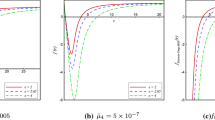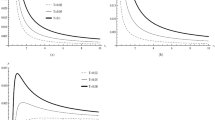Abstract
We study thermodynamic geometries of Myers–Perry (MP) black holes with arbitrary number of angular momenta. This geometric method allows us to visualize thermodynamic state spaces of the MP black holes as wedges embedded in a Minkowski-like parameter space. The opening angles of these wedges are uniquely determined by the number of spacetime dimensions d, and the number of angular momenta associated with the MP black holes, n. The geometric structure captures extremal limits of the MP black holes, and hence serves as a method for identifying the black hole’s extremal limit. We propose that classification of the MP black hole solutions should based on these uncovered structures. In order for the ultraspinning regime to exist, at least one of the angular momenta has to be set to zero. Finally, we conjecture that the membrane phase of ultraspinning MP black holes is reached at the minimum temperature in the case where 2n<d−3 based on the thermodynamic curvature obtained.





Similar content being viewed by others
Notes
For a comprehensive review on black hole thermodynamic geometries we refer the reader to e.g. [20] and references therein.
In order to study the Ruppeiner and Weinhold thermodynamic geometries one needs explicit functions of entropy or mass, therefore our list of formulas can potentially be useful for further investigations where explicit formulas are required.
Extremal black holes are those with vanishing temperature (because surface gravity is zero in the extremal limit). According to thermodynamics and statistical mechanics such black holes do not radiate thermally, even though there exists vacuum energy which is the zero-point energy of all the fields in space.
Thermodynamic geometry is a particular type of information geometry. This field is the study of probability distributions and information by means of differential geometry.
This point is sometimes referred to as Davies point, but it does not correspond to a phase transition of black holes. The change of phase of MP black holes has no relation to the divergence of the specific heat.
In this case the singularities are associated with phase transitions.
In the Poincaré turning point method the vertical tangent in the conjugacy diagram indicates change(s) of stability whereas nothing special concerning stability is expected along at the vertical tangent.
Here n denotes the number of angular momenta and d the number of dimensions.
References
R.C. Myers, M.J. Perry, Ann. Phys. (N.Y.) 172, 304 (1986)
R. Emparan, H.S. Reall, Living Rev. Relativ. 11, 6 (2008). arXiv:0801.3471 [hep-th]
R. Emparan, H.S. Reall, Phys. Rev. Lett. 88, 101101 (2002). arXiv:hep-th/0110260
H. Elvang, P. Figueras, J. High Energy Phys. 0705, 050 (2007). arXiv:hep-th/0701035
H. Iguchi, T. Mishima, Phys. Rev. D 75, 064018 (2007). arXiv:hep-th/0701043 [Erratum-ibid. D 78, 069903 (2008)]
J. Evslin, C. Krishnan, Class. Quantum Gravity 26, 125018 (2009). arXiv:0706.1231 [hep-th]
K. Izumi, Prog. Theor. Phys. 119, 757 (2008). arXiv:0712.0902 [hep-th]
H. Elvang, M.J. Rodriguez, J. High Energy Phys. 0804, 045 (2008). arXiv:0712.2425 [hep-th]
R. Gregory, R. Laflamme, Phys. Rev. Lett. 70, 2837 (1993). arXiv:hep-th/9301052
T. Harmark, V. Niarchos, N.A. Obers, Class. Quantum Gravity 24, R1 (2007). arXiv:hep-th/0701022
M.J. Rodríguez, in Proc. of the Twelfth Marcel Grossmann Meeting on General Relativity (World Scientific, Singapore, 2012), p. 523. arXiv:1003.2411
R. Emparan, R.C. Myers, J. High Energy Phys. 0309, 025 (2003). arXiv:hep-th/0308056
R. Emparan, T. Harmark, V. Niarchos, N.A. Obers, M.J. Rodríguez, J. High Energy Phys. 0710, 110 (2007). arXiv:0708.2181 [hep-th]
K. Murata, J. Soda, Prog. Theor. Phys. 120, 561 (2008). arXiv:0803.1371 [hep-th]
O.J.C. Dias, P. Figueras, R. Monteiro, J.E. Santos, R. Emparan, Phys. Rev. D 80, 111701 (2009). arXiv:0907.2248 [hep-th]
O.J.C. Dias, P. Figueras, R. Monteiro, H.S. Reall, J.E. Santos, J. High Energy Phys. 1005, 076 (2010). arXiv:1001.4527 [hep-th]
O.J.C. Dias, P. Figueras, R. Monteiro, J.E. Santos, Phys. Rev. D 82, 104025 (2010). arXiv:1006.1904 [hep-th]
O.J.C. Dias, P. Figueras, R. Monteiro, J.E. Santos, J. High Energy Phys. 1012, 067 (2010). arXiv:1011.0996 [hep-th]
M. Bouhmadi-Lopez, V. Cardoso, A. Nerozzi, J.V. Rocha, Phys. Rev. D 81, 084051 (2010). arXiv:1003.4295 [gr-qc]
N. Pidokrajt, Information geometries in black hole physics. Ph.D. Thesis, Department of Physics, Stockholm University, Sweden (2009)
J.E. Åman, N. Pidokrajt, Phys. Rev. D 73, 024017 (2006). arXiv:hep-th/0510139
S. Bellucci, B.N. Tiwari, J. High Energy Phys. 1101, 118 (2011). arXiv:1010.1427 [hep-th]
Z.Z. Ma, Class. Quantum Gravity 26, 135003 (2009)
P. Figueras, H.K. Kunduri, J. Lucietti, M. Rangamani, Phys. Rev. D 78, 044042 (2008). arXiv:0803.2998 [hep-th]
G. Ruppeiner, Rev. Mod. Phys. 67, 605 (1995). [Erratum-ibid. 68, 313 (1996)]
N. Pidokrajt, Information geometries in black hole physics. Ph.D. Thesis, Stockholm University, Sweden (2009)
D.C. Brody, D.W. Hook, J. Phys. A 42, 023001 (2008)
G. Arcioni, E. Lozano-Tellechea, Phys. Rev. D 72, 104021 (2005). arXiv:hep-th/0412118
S.W. Hawking, D.N. Page, Commun. Math. Phys. 87, 577 (1983)
P.C.W. Davies, Proc. R. Soc. Lond. Ser. A, Math. Phys. Sci. 353, 499 (1977)
J. Louko, S.N. Winters-Hilt, Phys. Rev. D 54, 2647 (1996). arXiv:gr-qc/9602003
A. Chamblin, R. Emparan, C.V. Johnson, R.C. Myers, Phys. Rev. D 60, 104026 (1999). arXiv:hep-th/9904197
H. Quevedo, Gen. Relativ. Gravit. 40, 971 (2008). arXiv:0704.3102 [gr-qc]
A.J.M. Medved, Mod. Phys. Lett. A 23, 2149 (2008). arXiv:0801.3497 [gr-qc]
J.E. Åman, I. Bengtsson, N. Pidokrajt, Gen. Relativ. Gravit. 38, 1305 (2006). arXiv:gr-qc/0601119
S.W. Wei, Y.X. Liu, C.E. Fu, H.T. Li, Adv. High Energy Phys. 2013, 734138 (2013). arXiv:0911.0270
S. Bellucci, B.N. Tiwari, J. High Energy Phys. 1005, 023 (2010). arXiv:0910.5314
Y.H. Wei, Phys. Rev. D 80, 024029 (2009)
R. Biswas, S. Chakraborty, Astrophys. Space Sci. 326, 39 (2010). arXiv:0905.1801 [gr-qc]
S. Chakraborty, T. Bandyopadhyay, Class. Quantum Gravity 25, 245015 (2008)
S. Bellucci, V. Chandra, B.N. Tiwari, arXiv:0812.3792 [hep-th]
L.Á. Gergely, N. Pidokrajt, S. Winitzki, arXiv:0811.1548 [gr-qc]
T. Sarkar, G. Sengupta, B.N. Tiwari, J. High Energy Phys. 0810, 076 (2008). arXiv:0806.3513 [hep-th]
Y.S. Myung, Y.W. Kim, Y.J. Park, Phys. Lett. B 663, 342 (2008). arXiv:0802.2152 [hep-th]
G. Ruppeiner, Phys. Rev. D 78, 024016 (2008). arXiv:0802.1326 [gr-qc]
A.J.M. Medved, Mod. Phys. Lett. A 23, 2149 (2008). arXiv:0801.3497 [gr-qc]
J.L. Álvarez, H. Quevedo, A. Sánchez, Phys. Rev. D 77, 084004 (2008). arXiv:0801.2279 [gr-qc]
J.E. Åman, N. Pidokrajt, EAS Publ. Ser. 30, 269 (2008). arXiv:0801.0016 [gr-qc]
H. Quevedo, A. Vázquez, AIP Conf. Proc. 977, 165 (2008). arXiv:0712.0868 [math-ph]
J.E. Åman, N. Pidokrajt, J. Ward, EAS Publ. Ser. 30, 279 (2008). arXiv:0711.2201 [hep-th]
B. Mirza, M. Zamani-Nasab, J. High Energy Phys. 0706, 059 (2007). arXiv:0706.3450 [hep-th]
J.E. Åman, J. Bedford, D. Grumiller, N. Pidokrajt, J. Ward, J. Phys. Conf. Ser. 66, 012007 (2007). arXiv:gr-qc/0611119
S. Wang, S.Q. Wu, F. Xie, L. Dan, Chin. Phys. Lett. 23, 1096 (2006). arXiv:hep-th/0601147
J.y. Shen, R.G. Cai, B. Wang, R.K. Su, Int. J. Mod. Phys. A 22, 11 (2007). arXiv:gr-qc/0512035
D.A. Johnston, W. Janke, R. Kenna, Acta Phys. Pol. B 34, 4923 (2003). arXiv:cond-mat/0308316
D. Astefanesei, M.J. Rodriguez, S. Theisen, J. High Energy Phys. 1008, 046 (2010). arXiv:1003.2421 [hep-th]
H.K. Kunduri, J. Lucietti, H.S. Reall, Phys. Rev. D 74, 084021 (2006). arXiv:hep-th/0606076
J.E. Åman, Manual for CLASSI: classification programs for geometries in general relativity. Technical Report, Provisional edition. Distributed with the sources for SHEEP and CLASSI. Department of Physics, Stockholm University (2002)
J.E. Åman, I. Bengtsson, N. Pidokrajt, Gen. Relativ. Gravit. 35, 1733 (2003). arXiv:gr-qc/0304015
Acknowledgements
Narit Pidokrajt acknowledges the KoF group, Fysikum, Stockholms Universitet for the warm hospitality, in particular to Hans Hansson for lending him a nice computer screen. NP would also like to thank the Royal Swedish Academy of Sciences (KVA) for supporting this project through the grant FOA10V-116. We kindly thank Ingemar Bengtsson for his enlightening and many useful comments, and acknowledge Gary Gibbons for giving us some useful information. NP would like to thank Roberto Emparan for stimulating discussions on MP black holes with equal spins while he was a visitor in Barcelona.
Author information
Authors and Affiliations
Corresponding author
Appendices
Appendix A: The MP black hole solution
The MP solutions have to be treated separately depending on whether the number of dimensions is odd or even. The black holes have (d−1)/2 angular momenta if d is odd and (d−2)/2 if d is even. The multiple-spin Kerr black hole’s metric in Boyer–Lindquist coordinates for odd d is given by
with the constraint
where m is mass parameter, μ i are directional cosines, and a i are parameters. The function Π is defined as follows:
The metric is slightly modified for even d. The event horizons in the Boyer–Lindquist coordinates occur where g rr=1/g rr vanishes. They are the largest roots of
The areas of the event horizon are given by
In d=5 there can be only two angular momenta associated with the Kerr black hole, thus the area of the event horizon reads
The Bekenstein–Hawking entropy is given by \(S= \frac {k_{B} A}{4G}\), and we can choose \(k_{B} = \frac{1}{\pi}\) and \(G = \frac {\varOmega_{(d-2)}}{4\pi}\) so that the Bekenstein–Hawking entropy for the MP black holes is simplified as
Appendix B: Extremal limits in multi-coordinates with all nonzero spin J equal
If 2n≥d−3 there will be an extremal limit at
This limit exists for 2n>d−3, which can be expressed in (M,S) coordinates as
or in (M,J) coordinates
For the case 2n=d−3 case (requiring odd d) we have S ext =0 and
For even d with all \(n = \frac{d}{2} -1\) spins we can also express
and
For odd d with all \(n = \frac{d-1}{2}\) spins we have
and
The Schwarzschild limit is when J=0 and this sets a physical bound to be
In Table 3 we present extremal limits in various coordinates.
Appendix C
We extend our discussion on the opening angles of the Weinhold metrics here with two subcases:
The subcase 2n=d−2
This applies to even dimensions, 4 with 1 spin, 6 with 2 spins etc. Here the transformation from u to σ is
Here we have \(u_{\mathrm{extr}} = \frac{\sqrt{d-3}}{2}\) which gives
The subcase 2n=d−1
This applies to dimension 5 with 2 spin, dimension 7 with 3 spins etc. Here the transformation is
In this case \(u_{\mathrm{extr}} = \frac{\sqrt{d-3}}{2\sqrt{2}}\) so we obtain
Rights and permissions
About this article
Cite this article
Åman, J.E., Pidokrajt, N. On explicit thermodynamic functions and extremal limits of Myers–Perry black holes. Eur. Phys. J. C 73, 2601 (2013). https://doi.org/10.1140/epjc/s10052-013-2601-9
Received:
Revised:
Published:
DOI: https://doi.org/10.1140/epjc/s10052-013-2601-9




